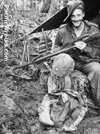2nd Lt. Thomas "Tommy" Harbaugh Roberts
Pilot, P-39Q Airacobra 42-19949 Missing In Action (MIA) January 12, 1944
Background
Thomas Harbaugh Roberts was born in Hot Sulfur Springs, Colorado. Nicknamed "Tommy". Prewar worked at a ranch as a hunter's guide.
Wartime History
Roberts enlisted in the U.S. Army Air Force (USAAF) as an aviation cadet and learned to fly the P-38 Lightning and was commissioned as a 2nd Lieutenant with serial number O-794504. During November 1943 sent overseas to New Guinea and assigned to the 25th Photographic Reconnaissance Squadron (25th PRS) based at 17 Mile Drome (Durand) near Port
Moresby but no aircraft were available to him.
 While on 21 day leave in New Guinea, Roberts volunteered to serve with the Australian Army 2/16th Battalion fighting at Shaggy Ridge and The Pimple (Sniper's Pimple). For his actions December 27-28, 1943 Roberts earned the Silver Star for gallantry in action. Afterwards, Roberts returning to 25th Photographic Reconnaissance Squadron (25th PRS) returned to flying duty as an Airacobra. While on 21 day leave in New Guinea, Roberts volunteered to serve with the Australian Army 2/16th Battalion fighting at Shaggy Ridge and The Pimple (Sniper's Pimple). For his actions December 27-28, 1943 Roberts earned the Silver Star for gallantry in action. Afterwards, Roberts returning to 25th Photographic Reconnaissance Squadron (25th PRS) returned to flying duty as an Airacobra.
Mission History
On January 12, 1944 Roberts took off piloting P-39Q Airacobra 42-19949 from 17 Mile Drome (Durand) near Port
Moresby at 10:32 on a local flight. Although listed as a non-combat flight, it is likely Roberts intended to overfly Shaggy Ridge to drop candy and cigarette to his buddies in the
Australian Army Australian Army 2/16th Battalion that he had served with the prior month. This aircraft was last seen headed inland with a one hour supply of fuel. When it failed to return, Roberts was officially listed as Missing In Action (MIA).
Memorials
 When he failed to return, he was officially listed as Missing In Action (MIA) the day of the mission. He is memorialized at at Manila American Cemetery on the tablets of the missing. Posthumously, he was promoted to the rank of 1st Lieutenant. When he failed to return, he was officially listed as Missing In Action (MIA) the day of the mission. He is memorialized at at Manila American Cemetery on the tablets of the missing. Posthumously, he was promoted to the rank of 1st Lieutenant.
Relatives
Ted Roberts (brother of Thomas Roberts)
During World War II, Ted Roberts served in the U.S. Navy aboard the USS Quincy. He retained his brother's prewar bolt action hunting rifle and his U.S. Army M1 Garand rifle used in combat on Shaggy Ridge.
Phil Bradley adds:
"I found out about "Tommy" Roberts when his brother Ted put a notice in the Australian newspapers asking for information about his brother's resting place. This led me to contacting his brother and then later visiting him in California. From Ted, I obtained the relevant documents relating to Tommy's loss as well as the story of his fascinating background. Tommy left home during the depression years and like many before him headed west. He ended up in Colorado, working on a ranch as a hunter's guide, and started to build a cabin. When the war came, his best hunting mate, David Hutchison talked him into joining the Air Corps and he trained in Colorado. Tommy was sent out to the Pacific in November 1943 as a trained P-38 pilot but was told he would have to wait for a plane. This didn't suit the young hunter, he wanted to fight the enemy. Colonel David "Photo" Hutchison was one of General Kenney's top airmen in the Pacific and worked particularly closely with the Australians. He arranged for Tommy to be attached to the Australian 2/16th Battalion on Shaggy Ridge. He fought alongside the Aussies and took part in the pivotal battle for the Pimple. When he returned to Port Moresby he was retrained as a fighter pilot on a P-39 and went missing on a solo fight, possibly on his way back to Shaggy Ridge to fly over his Aussie mates."
References
Missing Air Crew Report (MACR) 2287
AG 201 Roberts, Thomas H. 29 August 1949
American Battle Monuments Commission (ABMC) - Thomas H. Roberts
FindAGrave - 1Lt Thomas H Roberts (tablets of the missing)
PNG Museum Aircraft Status Card - P-39Q Airacobra 42-19949
Forty of the Fifth Profile 35 "The Hunter in Tommy Roberts" pages 103-108
On Shaggy Ridge pages 136-137, 139, 145, 152, 157-158
After the Battle Issue 135 "The Tommy Roberts Story" by Gail Parker
Thanks to Ted Roberts, Phil Bradley and John Douglas for additional information
Contribute Information
Do you have photos or additional information to add?
|